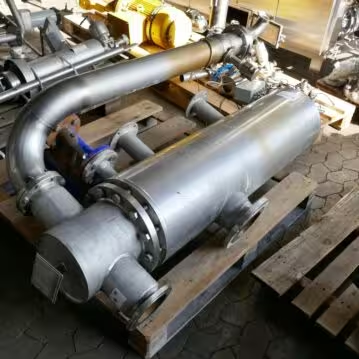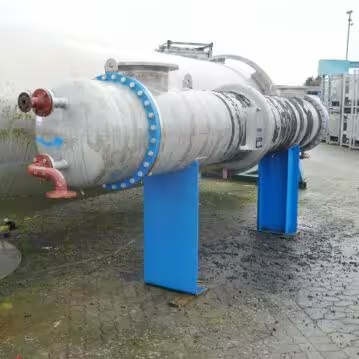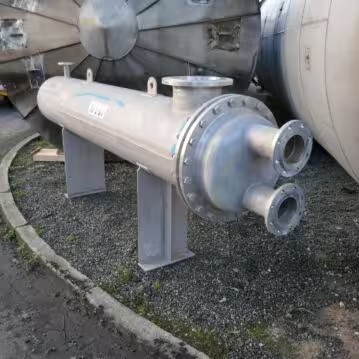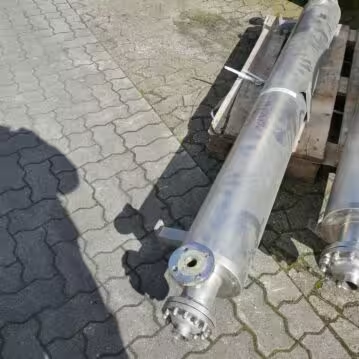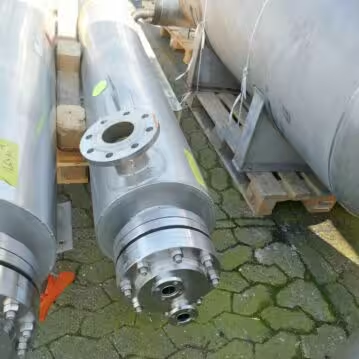Scambiatori di calore a fascio tubiero
Behälter KG offre scambiatori di calore a fascio tubiero usati e di alta qualità in pronta consegna. Gli scambiatori di calore a fascio tubiero sono costruiti in modo robusto e richiedono poco manutenzione. Per tanto risulta particolarmente conveniente acquistare uno scambiatore di calore usato che soddisfi le esigenze produttive. Date un’occhiate al nostro magazzino e in caso di domande non esitate a contattarci. read more...
Products
- ultimo settore d'utilizzo: Kosmetikindustrie
- Coibentazione : disponibile
- Materiale rivestimento coibentazione : Acciaio Inox
- Capacita´ intercapedine / Litri: 27 Litri
- pressione max. ammissibile nell'intercapedine / °C: 10,0 bar
Prezzo cadauno, IVA escl.
2 pezzi a maggazino
- Superficie di scambio / m²: 13,8 m²
- Documentazione tecnica:
- ultimo settore d'utilizzo: Brüdenwasser
- Capacita´ intercapedine / Litri: 1.400 Litri
- Materale Superficie: AISI316 (V4A) 1.4571
- pressione max. ammissibile nell'intercapedine / °C: 0,5 bar
Prezzo cadauno, IVA escl.
1 pezzo a maggazino
- Superficie di scambio / m²: 25 m²
- Documentazione tecnica:
- ultimo settore d'utilizzo: Methanol-Kondensator
- anno di costruzione: 2006
- Capacita´ intercapedine / Litri: 390 Litri
- Materale Superficie: AISI316 (V4A) 1.4571
- pressione max. ammissibile nell'intercapedine / °C: 0,5 bar
Prezzo cadauno, IVA escl.
1 pezzo a maggazino
- Superficie di scambio / m²: 1 m²
- ultimo settore d'utilizzo: Pharmazie
- Coibentazione : disponibile
- Materiale rivestimento coibentazione : Acciaio Inox
- Capacita´ intercapedine / Litri: 7 Litri
- Materale Superficie: AISI316 (V4A) 1.4571
- pressione max. ammissibile nell'intercapedine / °C: 6,0 bar
Prezzo cadauno, IVA escl.
1 pezzo a maggazino
- Superficie di scambio / m²: 5 m²
- ultimo settore d'utilizzo: Pharmazie
- anno di costruzione: 2009
- Coibentazione : disponibile
- Materiale rivestimento coibentazione : Acciaio Inox
- Capacita´ intercapedine / Litri: 45 Litri
- Materale Superficie: AISI316 (V4A) 1.4571
- pressione max. ammissibile nell'intercapedine / °C: 8,0 bar
Prezzo cadauno, IVA escl.
1 pezzo a maggazino
- ultimo settore d'utilizzo: Pharmazeutische Chemie
- Coibentazione : disponibile
- Materiale Coibentazione: Armaflex
- pressione max. ammissibile nell'intercapedine / °C: 6,0 bar
Prezzo cadauno, IVA escl.
1 pezzo a maggazino
- Superficie di scambio / m²: 6 m²
- Documentazione tecnica:
- ultimo settore d'utilizzo: Pharmazeutische Chemie
- anno di costruzione: 2007
- Coibentazione : disponibile
- Materiale Coibentazione: Armaflex
- Capacita´ intercapedine / Litri: 40 Litri
- Materale Superficie: AISI316 (V4A) 1.4571
- pressione max. ammissibile nell'intercapedine / °C: 3,2 bar
Prezzo cadauno, IVA escl.
1 pezzo a maggazino
How does a tube bundle heat exchanger function?
A tube bundle heat exchanger enables the heat transfer of two primarily liquid media by transferring the energy through a pipe wall. The exact construction of a tube bundle exchanger can vary. Typically, however, it consists of a solid tube, in which a large number of smaller transfer tubes are installed. One of the media flows through the transfer tubes, the solid tube surrounding the transfer tubes is filled with the second medium. The exchange surface of the heat transfer results from the amount and the diameter of the small transfer tubes. A shell-and-tube heat exchanger can be used to recover unused thermal energy in a production plant by transferring it to another medium. This can increase the overall energy efficiency.
What are the advantages and disadvantages of a tube bundle heat exchanger?
A shell-and-tube heat exchanger is much more robust and requires less maintenance. The transmission tubes are easy to clean, and the exchanger usually only has two seals installed. Due to the massive and simple design, tube bundle heat exchangers have a higher pressure resistance and are also suitable for very demanding temperature levels.
However, the heat transfer capacity from a tube bundle heat exchanger is lower than that of a comparable plate heat exchanger. Therefore, tube bundle heat exchangers are often larger in size and also heavier in weight. In addition, it is not possible to modify the design capacity of a tube bundle heat exchanger at a later point in time (in contrast to a plate-type heat exchanger).
